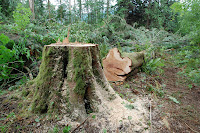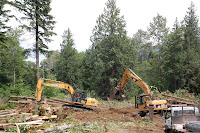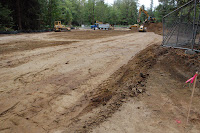 It did not begin with any ceremony, pomp, or circumstance. Instead, it began with a chain saw. The technological marvel called the railroad made the Northwest’s forest industry viable by providing economical transportation of raw logs to the mill and processed lumber to market. So it seems appropriate that a small, carefully planned logging operation would be required to build the Train Shed. And nothing was wasted. Good logs went for lumber, less desirable logs went for pulp, and everything else organic including the branches were ground up and sent to Simpson Timber’s plant to make steam.
It did not begin with any ceremony, pomp, or circumstance. Instead, it began with a chain saw. The technological marvel called the railroad made the Northwest’s forest industry viable by providing economical transportation of raw logs to the mill and processed lumber to market. So it seems appropriate that a small, carefully planned logging operation would be required to build the Train Shed. And nothing was wasted. Good logs went for lumber, less desirable logs went for pulp, and everything else organic including the branches were ground up and sent to Simpson Timber’s plant to make steam.
 Logging today is very different than just a generation ago. Excavators are used to control the tree falling. Access to the site is tightly controlled so there is no danger of anyone wandering into the work zone. Logs are sorted and piled with an excavator. And in implementing the Museum’s really aggressive tree retention plan, trees can be removed from a grove with almost surgical precision. It’s truly a remarkable experience to watch the process.
Logging today is very different than just a generation ago. Excavators are used to control the tree falling. Access to the site is tightly controlled so there is no danger of anyone wandering into the work zone. Logs are sorted and piled with an excavator. And in implementing the Museum’s really aggressive tree retention plan, trees can be removed from a grove with almost surgical precision. It’s truly a remarkable experience to watch the process.
 So about two weeks of effort later, the building corners are set – the pink ribbon in the photo is the actual location of the building corner. This is the south east corner of the building and in a few months this view to the north will incorporate 25,000 square feet of indoor exhibit space. An ambitious effort for any history museum, this project is unique in the Pacific Northwest. Progress will be updated on this blog and on the Museum’s web site at http://www.trainmuseum.org/
So about two weeks of effort later, the building corners are set – the pink ribbon in the photo is the actual location of the building corner. This is the south east corner of the building and in a few months this view to the north will incorporate 25,000 square feet of indoor exhibit space. An ambitious effort for any history museum, this project is unique in the Pacific Northwest. Progress will be updated on this blog and on the Museum’s web site at http://www.trainmuseum.org/

